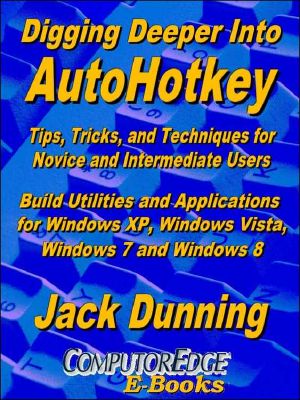Digging Deeper Into AutoHotkey

- Authors
- Dunning, Jack
- Publisher
- ComputorEdge E-Books
- Tags
- beginning , intermediate , windows , how-to , programming , novice , tutorial , autohotkey , script writing , free software , guide
- Date
- 2013-05-15T00:00:00+00:00
- Size
- 3.62 MB
- Lang
- en
Jack Dunning's goal in this book is to help the novice and intermediate script writer grow more familiar with AutoHotkey and its power through demonstrating real-world applications. The more someone understands the nuances of a scripting language, the easier it is to write simple applications. While the AutoHotkey Command listings on the Web technically give you everything that you need to write a script, the commands don't always work the way you may expect. Jack has tested everything in this book and explains how each scripts actually works (plus he highlights his mistakes with those commands).
While the most used AutoHotkey commands and techniques are included in this book, it is not a regurgitation of the list of AutoHotkey Commands. Everything is aimed at getting results, although the book is indexed by chapter for quicker reference. There are numerous graphic images included to highlight the scripts.
Each chapter in this book builds on the previous chapters and the book "A Beginner's Guide to AutoHotkey". Therefore, if you're brand new to script writing and AutoHotkey, it may be useful to start with the "Beginner's Guide," then dig into the first chapter of this and work your way through the process. If you're experienced with other languages, then jumping around for ideas may suit you. Since this is not specifically a reference book, Jack indexed the chapters making it easier to find specific AutoHotkey commands and techniques.
The first part of the book, "A Few Quick Tricks in AutoHotkey and Window Spy," includes a number of tips and short apps for the novice AutoHotkey script writer. Each chapter includes specific AutoHotkey techniques while offering tricks which can be put to use immediately.
Part II, "The Zen of Writing AutoHotkey Scripts," travels the holistic process of script writing while developing an app using the AutoHotkey dropdown menu to snap and resize windows on the Windows Desktop. Each AutoHotkey command used is explained in detail. Plus, an app to bring lost windows into view is analyzed.
Not every Windows program has built in backup. In Part III, "AutoHotkey for Quick Backup of Your Work, Anywhere, Anytime!," There are AutoHotkey techniques which can be used to protect your work--even when working on the Web.
Do you use Web browsers to do research? Make the data and URL collection process easier with the ideas found in Part IV, "Collect Data in One Pot." A free Scratchpad app (by another script writer) is discussed for its learning points.
Who needs the Start Menu in Windows 8? Or in Windows 7, or XP, for that matter? In Part V, "Quick Launch Links and Menus," there are two different approaches to creating Start Menu-like pop-ups. Jack still uses his AutoHotkey QuickLinks app which quickly navigates and loads favorite programs and Web pages. It's easy to set up and modify the QuickLinks code. There are even tips for adding the menu to the Windows Taskbar System Tray.
Microsoft Word has some pretty good autocorrection for commonly misspelled words. Now, with the AutoHotkey scripts found in Part VI, "AutoCorrect for All Windows Apps and AutoUpdating AutoHotkey on Multiple Computers," you can add all the same autocorrection (and more) to all of your Windows programs and Web pages. Plus, learn how to automatically update all of your AutoHotkey script on all of your computers with Dropbox.
The Reminder app discussed in Part VII, "Building the Reminder App Step by Step," started as a quick pop-up for an appointment later in the same day. The script writing process added a speaking voice reading the message and ultimately saves the reminder to disk.